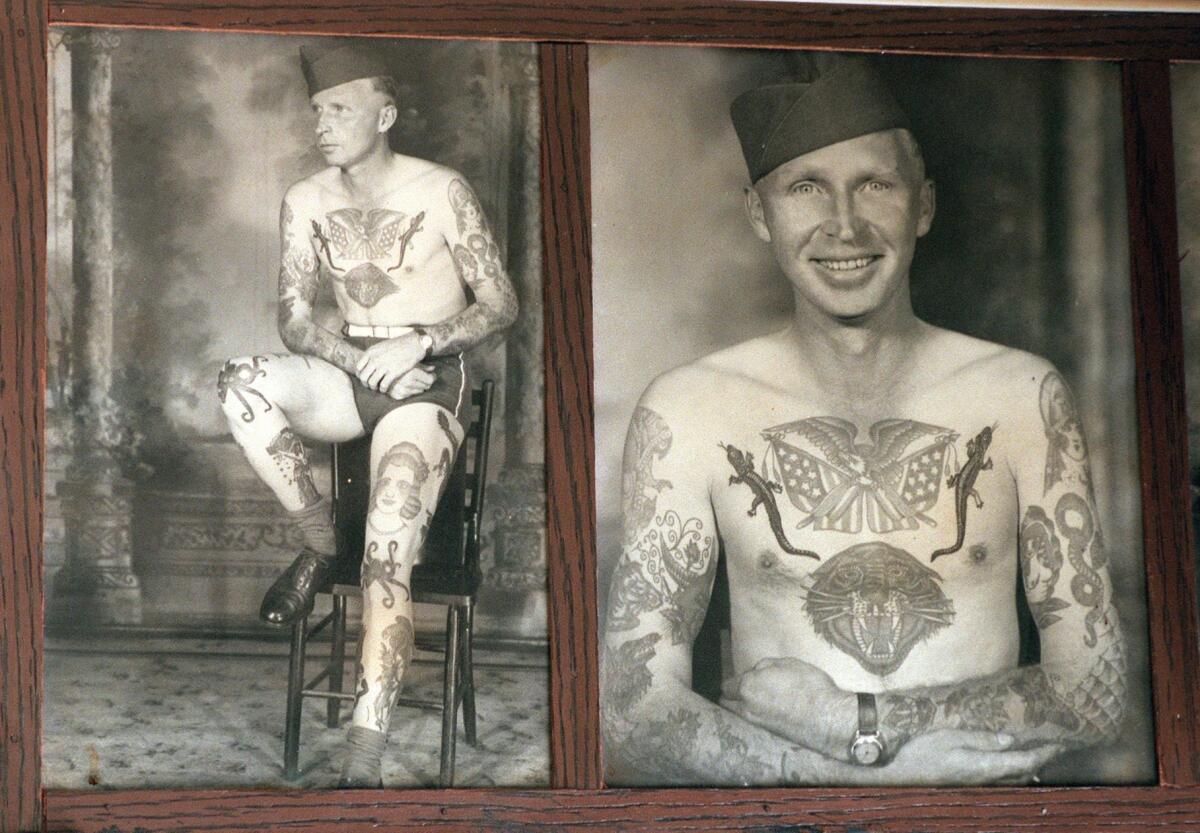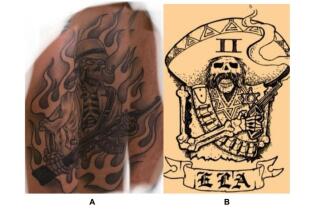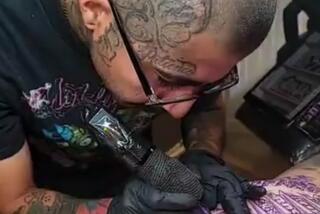From the archives:: A Tattoo landmark fades along with Long Beach’s naval operations

Bert Grimm’s Tattoo Studio used to need 10 full-time artists to keep up with the legions of sailors waiting to go under the needle.
There was the kid, fresh from boot camp, who wanted classic Navy emblems etched into his chest. The superstitious sea dog who thought tattoos of a chicken and a pig would keep him afloat. The love struck sailor who asked to have his sweetheart’s name inked on his arm forever, only to gasp in horror when the relationship fizzled weeks later.
“The place was really jammin’,” says Bobby Shaw, who now owns the Long Beach shop, believed to be the oldest tattoo parlor in the nation. “Now it ain’t nothing like it used to be.”
Today, the shop employs only two full-timers. The sailors have all but vanished, leaving nothing behind but a few dozen U.S. Navy-issue caps perched near the ceiling.
Once a shrine to the ancient maritime rite of getting tattooed, Grimm’s has witnessed the ebb and flow of the sailor, formerly its most reliable client, in this financially hard-pinched port city. The warships, and the crews they carried to and from Long Beach for nearly a century, have drifted away. The Navy’s last local foothold, its shipyard, is set to close in 1997.
From Grimm’s downtown storefront, artists have watched since 1927 as the Navy made its mark on Long Beach, home port to hundreds of ships during World War II, and the Korean and Vietnam wars. With painstaking care, they etched symbols of love or belief in God and country onto countless sailors waiting to go to battle.
With the departure of the Navy, the traditional tie between tattoos and sailors in Long Beach has withered. In towns such as San Diego and Norfolk, Va.--homes to two of the world’s largest naval bases--tattoo shops still ink crowds of sailors. But even in those Navy strongholds, today’s young seamen, with their better technical training and high school educations, seem less likely to want tattoos. In the Pentagon, image-conscious Navy officials also frown on the designs.
“It used to be a tradition, part of being in the Navy,” said Robert Audiss, 30, a Navy SEAL instructor in San Diego who got his first tattoo at Grimm’s in 1983, two years after he joined up. “Nowadays, I think more people outside the service have tattoos than people in the service.”
Grimm’s gets by on myth. Its artists count on repeat business and guard their reputations as craftsmen above all else.
A job at Grimm’s used to be considered the finest hands-on training an artist could get. The tattoo artists and sailors who listened to the needle’s buzz say the shop’s own lore, like its excruciating artwork, will last forever. Says Dave Gibson, an artist in the studio during the early 1980s: “I think it’s the coolest tattoo shop in existence.”
Grimm’s walls are lined with sheets of tattoo designs ranging from plain (roses) to elaborate (sailing scenes). Customers wishing to become walking artwork for about $30 to $125 can choose from hundreds of images: an ark’s worth of animals plus cartoon characters (including Popeye the sailor, who himself bears a large anchor tattoo on his bulging forearm) and sundry symbols of love and hate. One sheet among the dozens offers traditional Navy tattoos, with prints of winding ropes and a sinking ship above the words “Sailor’s Grave.”
Framed black-and-white photographs of sailors with fresh tattoos, many drawn by Grimm himself in the 1950s, hang in corners and along the ceiling, advertising the shop’s most visibly patriotic clients. In one graying picture, a smiling sailor shows off his full-chest tattoo, a submarine propeller in front of a waving American flag. In another, a young sailor faces away from the camera, displaying an elaborate image scrawled across his entire back: a sailing vessel floating above the words Homeward Bound, flanked by two huge flying fish.
Looking back across the years, manager Rick Walters says the shop’s busiest days came with the regularity of military paychecks. Many young sailors had little else to spend their money on.
During the shop’s heyday, servicemen would wait for up to three hours for Grimm’s artistry. Even when some grew impatient, wandered to the nearest pub and returned inebriated, the shop wouldn’t turn them away.
Walters says he usually refuses to tattoo drunk customers because they won’t sit still and they’ve been known to cause a mess. With Navy clients, however, he made an exception: “There’s not much you can do when the place is full of sailors.”
But it’s been years since the shop saw that kind of crowd. To some, it seems the centuries-old sea custom of being tattooed is fading. Across the country, the tattoo industry is increasingly linked to body piercing, and its most common customers are young rebels and bikers, artists say.
“There was a different class of Navy back then,” Gibson says of the golden years. “They were into having fun.”
To be sure, some sailors still consider a tattoo to be a rite of passage, part of one’s identity. But the Navy disapproves of that idea, citing the risk of infection and, perhaps more telling, its distaste for its old salty dog image.
The inky tradition’s link to the Navy dates to the 18th Century, when the seas were uncharted and most ships were built for exploration, not war. Capt. James Cook, a veteran of the English Navy, mapped the South Pacific, encountering curious islands and curious cultures along the way.
“The sailors, as souvenirs, got tattoos,” says Chuck Eldridge, who runs the Tattoo Archive in Berkeley. “Because [Cook] was a Navy man, [tattooing] instantly became associated with it.”
The tradition traveled to the New World, he says, and has been tied to the American military ever since.
Eldridge, himself a seaman aboard the aircraft carrier Oriskany in the 1960s, received his first four tattoos--a sailing vessel, an anchor, an eagle and a woman--immediately after he finished boot camp. Eldridge says he’s lost track of the number of tattoos he has, but 75% of his body is covered.
According to a U.S. Naval Medical Bulletin dated 1913, a study of enlistees joining the service found that 23% had tattoos when they signed up. When the same men were examined one enlistment period later, 53% had tattoos.
Of course, choosing the proper design, whether it was a symbol of belief, superstition, loyalty or identity, was as important as having a tattoo. And Grimm’s has seen them all.
Some sailors wanted huge, sweeping ocean scenes on their chests or backs. Others asked for pinup girls, or anchors, or patriotic emblems. More than one sailor has decided to have two ship propellers, or screws, tattooed on his derriere.
One poor seaman walked into Grimm’s looking for a bit of a touch-up job. At another shop, an artist apparently unschooled in mechanics had drawn two right-facing screws on the sailor’s behind.
“If you have two right-handed screws, you’ll go in circles,” Walters says, chuckling.
Another request came from a sailor who asked to have a chicken inked on one foot and a pig on the other, believing that the animals would prevent him from ever going down with his ship.
Other symbols became Navy fads without rhyme or reason.
Don Nolan, who worked at Grimm’s from 1963 to 1970, recalls tattooing a design he called “The Zig Zag Man” on a number of sailors. The image, a tribal figure wearing a hat, was a sign used by marijuana users.
“I remember one guy, when I got halfway done with the piece, said, ‘What does this mean?’ I told him it was a French fisherman,” says Nolan, who now owns a shop in St. Paul, Minn.
Sailors’ tastes in tattoos tend to change with the times, say the artists. Though the designs can be badges of honor, they occasionally become mere labels.
“When they’re not at war, they don’t seem to be as patriotic,” Walters says. “When it’s wartime, they get more patriotic. We do a lot of American flags and pictures of Christ.”
“Usually, the Navy guys are more likely to get anything other than a Navy tattoo,” Gibson says. “They don’t want to be identified as lifers.”
But no matter the choice of design, he adds, the military always has been a reliable customer base--so reliable that tattoo parlors spring up wherever bases open. After leaving Grimm’s, Gibson initially moved to Everett, Wash., to open a shop when he heard the Navy might be building a facility there in 1987. Now Gibson runs Lucky’s Tattoos in San Diego and estimates that half of his clients are sailors or Marines.
The Pentagon insists it has no official policy on tattoos. But, informally, officials say sailors are discouraged from carrying on the tradition.
“There’s a great danger of getting an infection,” says Cmdr. Steve Burnett, public affairs officer for the U.S. Naval Base in San Diego. “It’s usually girlfriend- or cruise-related. Of course, we try to counsel young sailors about tattoos. One of the problems is, the things don’t come off that easily.” Relationships, he pointed out, aren’t always as lasting.
In the Marine Corps, a task force of senior enlisted personnel concerned that too many Leathernecks are abusing their bodies recommended development of a policy on tattoos to define what’s acceptable and what’s over the line.
Javier Hinojos, now a Navy recruiter in Pomona, says his superiors have frowned on tattoos, especially politically incorrect designs, including the traditional image on a sailor’s arm: a nude woman.
“It can’t be anything suggestive or less than professional,” said Hinojos, who got his first two tattoos--a rose with the word mother, and a broken heart pierced by a knife--in 1985 after serving on the Kiska, an ammunition ship.
“I was sober when I picked them,” he says. “The myth is, if you’ve been drinking, it doesn’t hurt. It hurts.”
But neither the military’s disdain nor the pain stop all of today’s sailors from putting ink to skin. Ask seaman Jack Audiss.
Audiss, 28, got his first tattoo, a pinup girl on his back, at Grimm’s about 10 years ago, not long ago after his brother Robert got one. He had nude women inked on both arms, which are “sleeved”--covered with tattoos. But then he tried to join the Navy two years ago and met with a recruiter.
“She told me they couldn’t let me in because of all the naked women I have,” said Audiss, who is now stationed in San Diego. “I was put at a standstill until I got them covered up.”
He had an artist draw bikinis on the women in four of his images, and then officially enlisted.
“I had to ruin my tattoos, basically,” he laments. “But it was worth it.”
Audiss, nicknamed “Captain Jack” by his colleagues for his old-time mariner appearance, says he was attracted to the traditional sailor look of the 1940s and 1950s.
“I like that era a lot,” he says. “I look like a salty dog.”
Audiss says his father, a retired Marine, got his first tattoo, a Playboy bunny, at Grimm’s. The shop “has always been kind of important to me.”
Not even the parlor’s owners know for certain who opened it seven decades ago. Grimm, a tattoo artist and farmer who moved to Long Beach from St. Louis after suffering a heart attack, purchased the shop around 1950. He once practiced his craft while traveling with Buffalo Bill Cody’s Wild West caravan. Grimm ran the Long Beach studio until 1965 when he sold it for $50,000 and retired to Seaside, Ore. He died in 1985 at age 86 with more than 300 tattoos.
Considering the shop’s surroundings in the 1950s, Grimm would have been hard-pressed to find a better location. Jutting out from the basement of a downtown apartment building not far from the waterfront, the studio became part of the Nu-Pike zone, a Coney Island-style beachfront amusement park area that drew throngs every weekend.
“It was the entertainment capital of the world for sailors,” recalls David Graham, president of the Battleship Assn., a sailors’ organization.
With hordes of customers attracted to “the Pike” and sailors’ patriotism swelling as tensions rose in Southeast Asia, the shop blossomed. Business was so good, in fact, that three other tattoo studios sprang up within view of Grimm’s. Amid bitter feuding among the shops, Grimm eventually bought out his rivals. The amusement area filled the studio with an air of excitement that artists say is unlikely to return.
On a July 4 in the mid-1970s, a woman exploring the Pike ventured into the shop and accidentally dropped her purse on the floor. A pistol she kept in the handbag went off, firing a bullet into a tattoo sheet-covered wall. The bullet pierced the image of a sinking ship.
The metaphor was already on its way to matching reality.
The number of warships based at the Long Beach Naval Station was plummeting. The Pike dismantled its centerpiece, the mile-long Cyclone-Racer roller coaster, in 1972, and the amusement park would close altogether in 1979.
Business at the parlor has fallen off since then, with a brief resurgence in the early 1980s when the Navy overhauled a number of ships at the Long Beach shipyard.
Now, with its steady crop of sailors gone, Grimm’s has adjusted. Artists now tattoo a wildly diverse clientele, including attorneys, doctors, clergymen and bikers.
Sitting behind the wooden counter in Grimm’s “Tattoo Alley” where he practices his craft, Walters takes a sip from his Persian Gulf War mug and reflects on war, peace and the shop’s decline. He sounds like a weathered captain, speaking in tribute to his vessel.
“She’s not making the money she did back then, but she’s not going broke,” he says. “She’s doing all right.”
More to Read
Sign up for Essential California
The most important California stories and recommendations in your inbox every morning.
You may occasionally receive promotional content from the Los Angeles Times.










